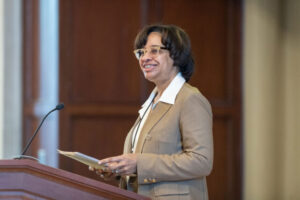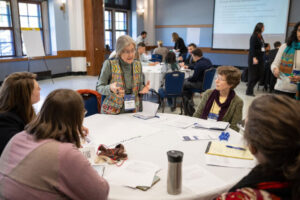Q+A with Vice Provost for Undergraduate Education Angela Dillard

Angela Dillard, U-M’s inaugural vice provost of undergraduate education, addresses attendees at the Provost’s Seminar on Teaching. (Photo by Scott Soderberg, Michigan Photography)
Angela D. Dillard, the Richard A. Meisler Collegiate Professor of Afroamerican and African Studies, began her five-year appointment as vice provost for undergraduate education (VPUE) on January 1, 2024. The VPUE will be responsible for leading, overseeing and advancing continual improvements in education, including accreditation, for undergraduate students in partnership with schools and colleges that enroll undergraduate students.
At a recent Provost’s Seminar on Teaching co-sponsored by the Center for Research on Learning and the Provost’s Office, more than 130 faculty, staff and administrators joined Vice Provost Dillard, Provost McCauley, and a panel of visiting student success experts from other universities to discuss the future of undergraduate education at the university.
What’s it like to occupy an inaugural position and begin in January?
AD: It’s a little like moving into a big and empty house, which is both inviting and intimidating. This “house” has good bones and an equally good view. And, as my cousins in real estate would say, location is everything; if you have that right then everything else will eventually fall into place. My location in the Provost Office is excellent for the kind of cross-campus work I’ve been tasked with undertaking, and I have enjoyed exploring this “neighborhood.” A January 1 start date is always challenging as everyone returns from winter vacation, and can make onboarding tricky – even more so if your first days correspond to a national championship football game. January 5, 2024, which was my first full day in the office; many new colleagues were in Houston with the team, preparing to bring home that Natty. Not that I’m complaining! I roamed freely and started to dream big, making plans for my first 100 days – plans that will, I hope, lay the foundations for realizing all of the potential of this new position.
You’re charged with building student academic success initiatives at Michigan. What exactly does that mean?
AD: Bringing aspects of the national student success movement to Michigan is at the top of my “to do” list. One of the distinctive features of this movement is to encourage institutions to look to their own structures and assumptions as explanations of persistent gaps in the 4 and 6 year graduation rates; for high levels of students dropping, failing, and withdrawing from courses and for problems in student retention and achievement. Instead of blaming students for being unprepared; the student success movement tends to put the blame on institutional systems. It’s not them, it’s us, for short. One major recommendation for addressing the consequences of gaps in equity and opportunity among students is to encourage everyone to register for and complete 30 credits in their first year. It’s called Early Momentum and a mountain of data generated here and nationally has equated early success with a full academic load as a good predictor of long-term success in retention and graduation. These data also tell us that no category of students (e.g., Pell-eligible and first generation students or student athletes) are harmed by institutions setting this expectation. It does, however, require us to reconsider some of our current practices around advising, teaching, and academic supports, ideally in the context of student well-being and mental health. Indeed, I have a full set of recommendations from the Well-Being Collective’s Academic Policies Work Team that have already been extremely useful for thinking through the intersections of student success and student wellbeing.
How will you go about this work?
AD: Using data analytics and qualitative analysis we can better understand gaps in opportunities and then begin to design remedies. I’ll be working closely with the Analytics for Student Success and Equity Transformation (ASSET) team, which is a group of researchers, faculty, and administrators from several colleges, schools, and offices who investigate questions related to equity and student success. Their goal is to provide people like me with analysis that informs decisions about policies and practices that impact students in differential ways. They publish a newsletter distributed twice each fall and winter semester. Their February edition (February 2024.) includes an analysis of “credit gaps” that exist even before students matriculate at Michigan. Students who attended high schools that offer robust Advanced Placement classes, for example, come in with a block of credits that provide advantages. Such students have a buffer that allows them to take a lighter load, withdraw from a course without major credit consequences, and even to skip some introductory courses. If your high school did not offer AP courses then you missed this opportunity. We explored the intersection of data analysis and creative problem solving at the February Provost’s Seminar on Teaching (“Undergraduate Education at Michigan: Forging a Common Vision”).

Catherine Badgley, director of the Residential College and professor of ecology and evolutionary biology, and in the Residential College, and of earth and environmental sciences in LSA, leads a discussion at the Provost’s Seminar on Teaching on Feb. 20 at the Michigan Union. (Photo by Scott Soderberg, Michigan Photography)
The seminar brought national leaders in the student success movement to campus to share their experiences with Early Momentum and other recommended practices. It also offered faculty, advisors and student life professionals concurrent working sessions geared toward creating action plans for our campus. I’m fortunate that much of the groundwork has been laid by ASSET and by various task forces over the years that have produced a solid set of recommendations for continuous improvements in undergraduate education. I intend to honor – and act on – the work that has already been done while staying open to new ideas and innovations from all parts of campus. I mentioned the recommendations from the Wellbeing Collective above. There is also the report from a Post-COVID Grading Committee, for the Initiative Planning Group on Academic Student Success, and from the Task Force on Undergraduate Education in the Third Century, from 2019. We have no shortage of ideas to pursue together.
What about students themselves? Do you have plans to involve them?
AD: Students were involved in and consulted in all of the reports I mentioned above, and I value their insights and reflections. In fact, one of the first meetings I did back in December after I was appointed and as I began to prepare for this role was to meet with the student leadership of optiMize, which is a partnership between a student organization and the LSA Dean’s Office. (It’s LSA’s main social innovation and entrepreneurship effort that serves students of all ages, from first years to PhD candidates, from all degree programs on all three UM campuses, as well as transfer students through optiMize’s community college partnerships and programs: aMplify and moMentum). Each year they sponsor the Social Innovation Challenge that provides mentorship and community support for student teams to turn their ideas into action. I worked closely with them when I was LSA’s associate dean for undergraduate education and very much wanted to reconnect. As part of this year’s Challenge, student teams will be invited to pitch their best ideas to me for promoting academic achievement and student success at scale. The winners will be offered paid fellowships to further develop their ideas and innovations over the summer. I can’t wait to hear what our talented optiMize students come up with, and I look forward to developing partnerships with other student orgs and associations. I’ve learned a lot from student innovators over the years about the necessity of being bold and taking risks, about the power of diverse teams and active collaboration, and about what our students can do to change the world.

